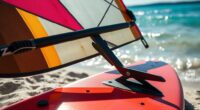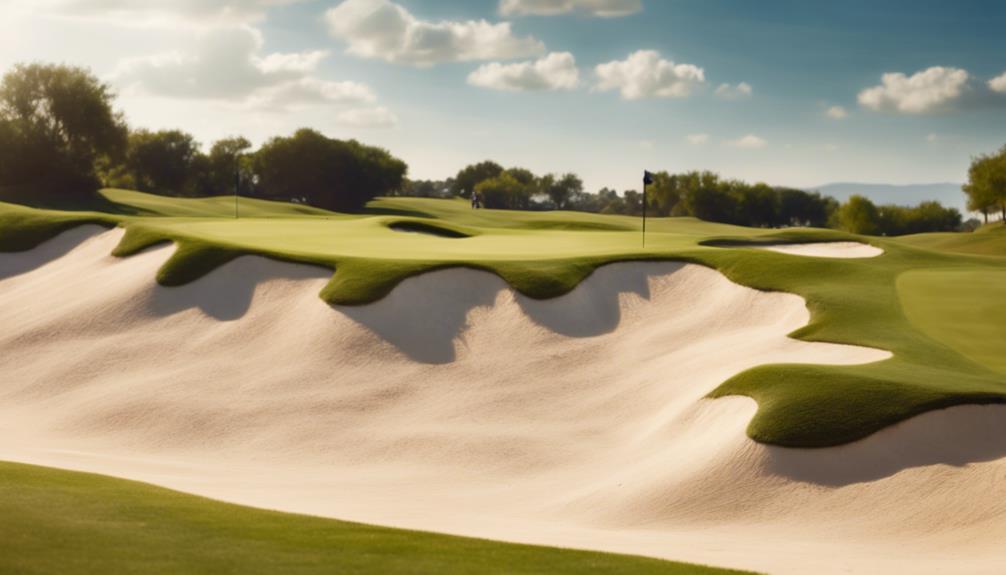To improve your paddleboard stability as a beginner, start with basic balance drills on a stationary board, focusing on weight distribution and small movements. Practice kneeling exercises to build confidence and shift seamlessly to standing by shifting your weight and engaging your core. Work on forward and side-to-side weight shifts, then practice turning and pivoting for better maneuverability. Keep practicing these skills; you’ll find your balance improves with each session and more tips await you.
Key Takeaways
- Practice basic balance drills on a stationary board to develop core stability and weight distribution.
- Use kneeling stability exercises to build confidence before standing.
- Master transitioning from kneeling to standing with controlled movements.
- Perform forward and side-to-side weight shifts to improve weight control and center awareness.
- Practice turning and pivoting to enhance maneuverability and stability on the board.
Basic Balance Drills on a Stationary Board
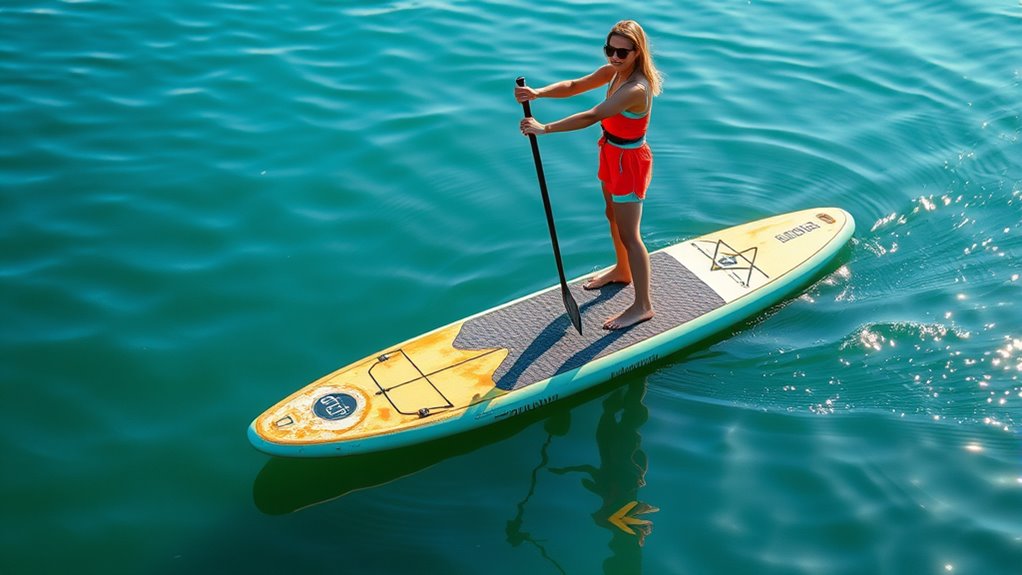
To build your foundational balance skills, start with basic exercises on a stationary paddleboard. Begin by standing with your feet shoulder-width apart, feeling the board beneath you. Focus on keeping your weight evenly distributed, engaging your core muscles to maintain stability. As you get comfortable, try shifting your weight slightly forward and backward, noticing how the board responds. Next, practice small side-to-side movements, maintaining control without losing balance. Keep your knees slightly bent and your gaze fixed ahead to improve stability. These simple drills help you develop body awareness and confidence on the board. Remember, patience is key—mastering these basics sets a strong foundation for more advanced paddling and balance challenges ahead. Incorporating core strength exercises can further enhance your stability and overall paddling performance. Additionally, practicing body awareness through these drills can further refine your control and stability during paddling, which is supported by training techniques that focus on proprioception and muscle engagement.
Kneeling Stability Exercises to Build Confidence
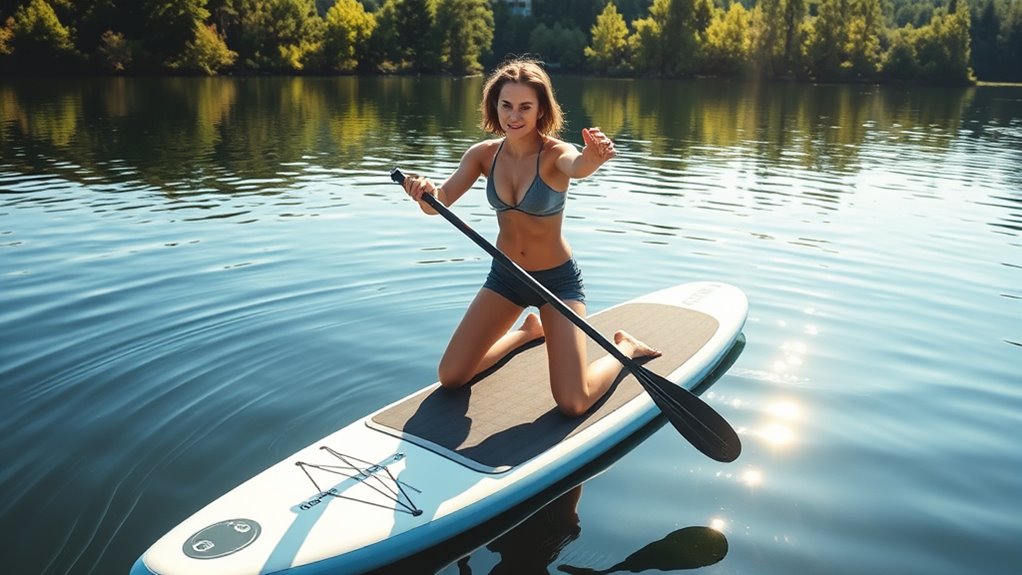
Once you’ve gained confidence balancing on your feet, try kneeling on the paddleboard to further build stability. Kneeling lowers your center of gravity, making it easier to stay balanced. Begin by kneeling with your knees shoulder-width apart and your hands resting on the board for support. Focus on maintaining a straight back and engaging your core muscles. Practice shifting your weight gently from side to side, feeling how your balance adjusts. You can also try small turns or leaning slightly forward and back to improve control. Keep your movements slow and deliberate, building confidence with each attempt. This exercise helps you develop stability, so when you’re ready to stand, you’ll feel more secure and in control on the water. Incorporating core engagement techniques can also enhance your overall balance and stability during paddleboarding. Developing an awareness of small mistakes can help prevent common pitfalls and improve your technique, making your paddling experience safer and more enjoyable. Improving AI safety measures can also enhance the development of reliable safety protocols for beginners.
Transitioning From Kneeling to Standing
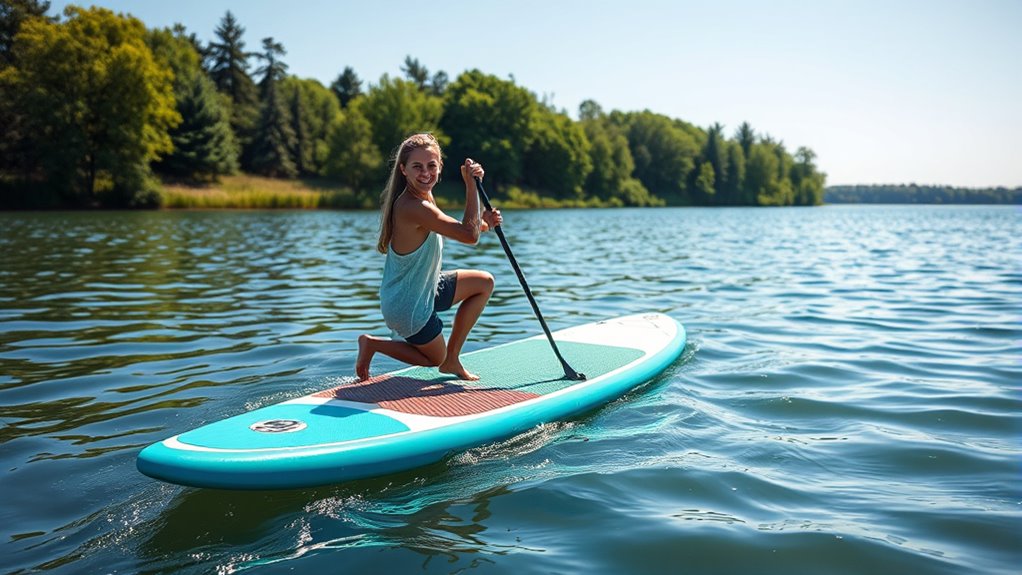
As you prepare to stand up from kneeling, focus on maintaining your balance and controlled movements. Keep your hands firmly on the board’s deck for stability, and engage your core muscles to support your shift. Start by placing one foot flat on the center of the board, keeping your knees slightly bent. Slowly shift your weight forward onto that foot while simultaneously pushing up with your hands. As you lift your hips, bring your other foot up to join the first, maintaining a low, stable stance. Stay centered and avoid rushing; deliberate, smooth motions help prevent wobbling. Once upright, find your balance, keep your knees slightly bent, and look forward to stay steady. This controlled transition builds confidence and prepares you for more advanced paddleboarding techniques. Focusing on your balance and stability during this movement will help you develop better control on the water. Additionally, practicing core engagement can further enhance your overall stability and ease of movement. Incorporating body awareness techniques can also improve your ability to respond to shifts in water conditions and maintain your posture. Developing awareness of your visual focus can help improve your overall stability and reaction time.
Forward and Side-to-Side Weight Shifts
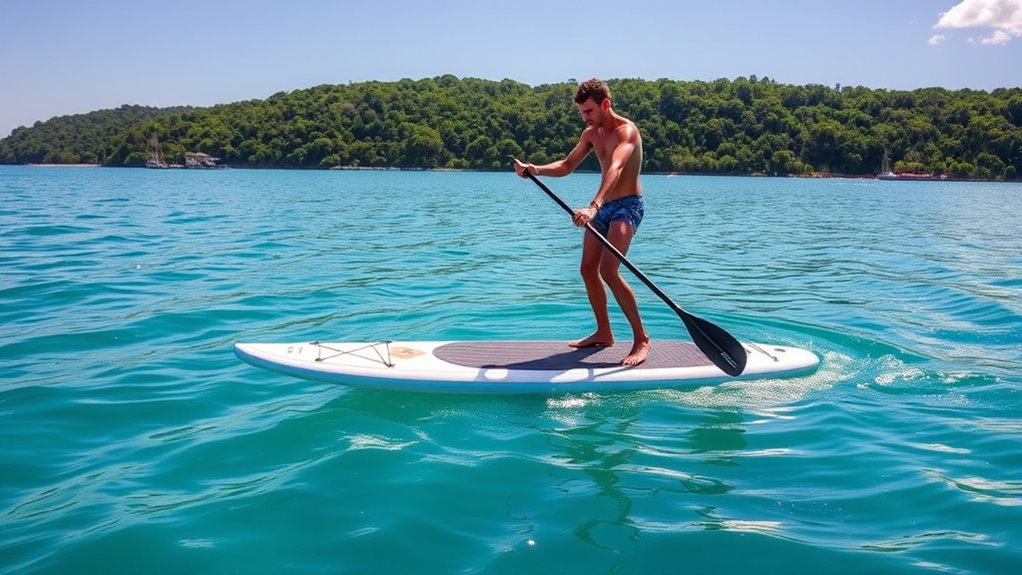
Mastering forward and side-to-side weight shifts is essential for maintaining stability on your paddleboard. By shifting your weight intentionally, you improve balance and control, especially in challenging conditions. To practice effectively:
- Start by standing centered on your board with feet shoulder-width apart.
- Shift your weight slowly forward, feeling how your toes engage to keep balance.
- Then, gently move your weight side to side, feeling the pressure on each foot.
- Repeat these movements, focusing on smooth, controlled shifts without losing your balance.
- Developing proper technique enhances your overall stability and confidence on the water.
- Incorporating mindfulness during these drills can help you stay focused and improve proprioception.
- Consistent practice helps you develop kinesthetic awareness, making it easier to respond to waves and wind.
- Understanding your center of gravity can further improve your ability to make precise weight shifts, as awareness of your balance system is crucial for effective adjustments.
Practicing Turning and Pivoting Skills
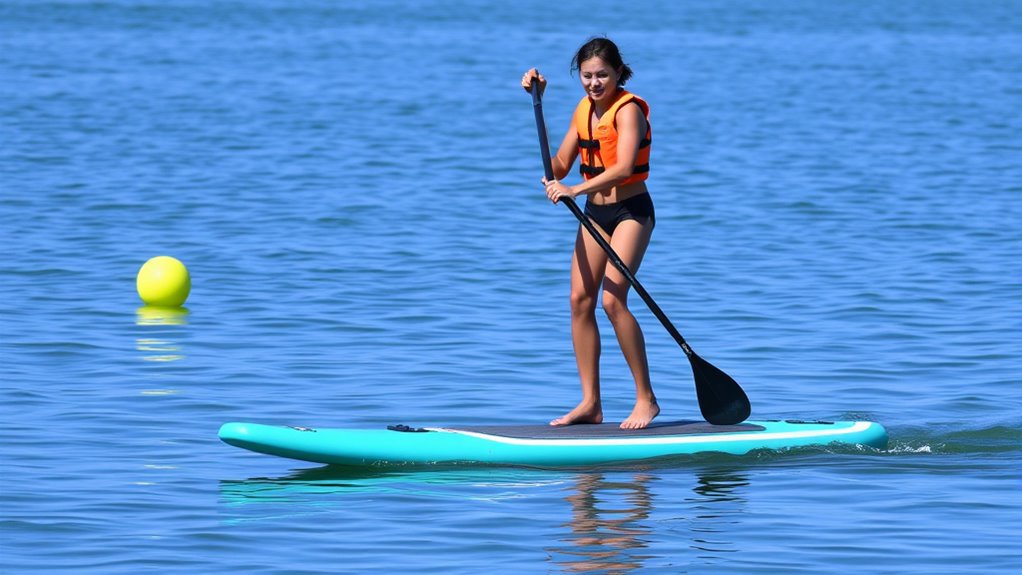
Practicing turning and pivoting skills is essential for gaining maneuverability and control on your paddleboard. To start, practice gentle turns by shifting your weight slowly from side to side, engaging your core and hips. Focus on leaning slightly in the direction you want to turn, keeping your paddle in the water for stability. For pivoting, position your feet shoulder-width apart and turn your upper body while keeping your lower body steady. Use small, controlled movements to avoid losing balance. As you become more comfortable, challenge yourself with sharper turns and quick pivots. These skills improve your confidence and help you navigate around obstacles or change direction smoothly. Regular practice ensures you develop precision and fluidity in your turning and pivoting techniques. Additionally, incorporating scenic views and charming local shops can make your practice sessions more enjoyable and relaxing. Remember that consistent practice enhances your overall personal and community resilience, making your skills more reliable in real-world situations. Incorporating proper paddleboard maintenance can also ensure your equipment remains in optimal condition for effective practice.
Frequently Asked Questions
How Can I Improve My Paddleboarding Balance in Windy Conditions?
When facing windy conditions, you can improve your paddleboarding balance by adjusting your stance, keeping your feet shoulder-width apart, and bending your knees slightly. Focus on maintaining a steady gaze, looking toward the horizon rather than down. Use your core to stay stable and make small, controlled paddle strokes to keep the board steady. Practice in varying conditions to build confidence and develop better balance over time.
What Are the Best Safety Tips for Beginners on a Paddleboard?
You should wear a life jacket, check weather conditions, and stay close to shore. Keep your leash attached, so you don’t drift away, and carry a whistle to signal for help if needed. Practice getting on and off your board safely, and always stay alert to your surroundings. By following these safety tips, you’ll enjoy your paddleboarding experience confidently and securely, no matter where you venture.
How Often Should I Practice Stability Drills for Progress?
You should practice stability drills regularly to see steady progress, ideally 2-3 times a week. Consistency helps you build confidence and improve your balance over time. Keep sessions short at first, around 15-20 minutes, and gradually increase as you get more comfortable. Remember, practicing more often, but with proper technique, guarantees faster improvement and helps you stay safe on the water.
Can These Drills Help With Advanced Paddleboarding Techniques?
Pondering if beginner drills boost boldness in bold moves? Absolutely! These foundational exercises foster focus, fluency, and finesse, which are vital for mastering advanced paddleboarding techniques. When you build balance, bolster confidence, and develop core control through consistent stability drills, you set a solid stage for tackling tricky techniques like turns, tricks, and tricky terrain. So, yes—practice these drills regularly to refine your finesse and forge a fearless, fluid flow on the water.
What Equipment Enhances Stability During Beginner Practice Sessions?
To improve your stability during beginner paddleboarding sessions, using the right equipment makes a big difference. You should consider a wider, thicker board, which offers more balance and control. A leash keeps you connected to your board, preventing falls. Additionally, a non-slip deck pad provides better grip for your feet, helping you stay steady. Using these tools will boost your confidence and make your practice sessions safer and more enjoyable.
Conclusion
As you glide across the water, feel the gentle sway of your paddleboard beneath you. With each drill, your confidence grows, and balance becomes second nature. Imagine the sun warming your back and the breeze whispering around you as you master turning and shifting effortlessly. Soon, you’ll float smoothly, your movements fluid and controlled. Embrace the journey, and let the rhythm of the water carry you to peaceful, balanced adventures on your stand-up paddleboard.


